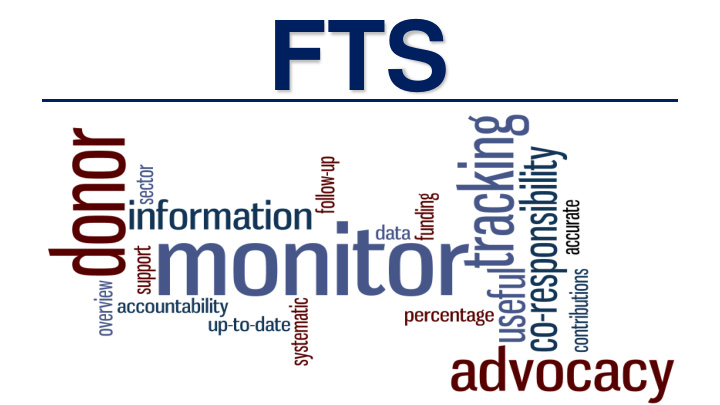



FTS
Topics for discussion What is FTS? Key facts, data sources, stakeholders Key challenges Standard reports and special FTS features
What is FTS ? Tool to improve coordination, resource allocation decisions, and advocacy Real-time snapshot of humanitarian contributions to natural disasters and complex emergencies, including all Consolidated and Flash Appeals) and contributions outside appeals (bilateral, Red Cross/Red Crescent, etc.)
What does FTS allow you to do? Monitor funding status of any appeal Monitor humanitarian funding outside the appeal Create quick donor profiles Analyze funding trends
How can FTS help you? Save time Provide information for advocacy Facilitate resource allocation decisions
Who uses the information? Humanitarian community: Donors, HCs and Humanitarian Country Teams, field and global clusters, operational agencies, host country governments. Media: FTS figures are frequently quoted. Academic community: Researchers, academics, think tanks, policy institutes.
OCHA: Official policy to use FTS figures for all information products.
FTS
FTS
“Funding for education in humanitarian emergencies has “The primary tool for collecting data was the improved in real terms and Financial Tracking Service (FTS) managed by the UN reached a high of US$359m in Office for the Coordination of Humanitarian Affairs 2010. However, in 2010, education (UNOCHA).” received only 2.3% of all humanitarian funding.” (source OXFAM ISSUE BRIEFING JULY 2012 YOU HAVE BEEN WARNED FTS) One year on from UN declaration of famine, Somalia faces worsening food crisis From: Making it happen: Financing education in countries affected by conflict “See UN OCHA Financial Tracking and emergencies Service (accessed 13 July 2012)”
How many contributions are recorded each year?
Average 10,000 records a year! (2006-2011)
Where does the information come from? ECHO’s Donor missions, UN Agency CERF Secretariat OCHA NGO field offices and EDRIS system headquarters and pooled fund field offices field offices ministries managers in the field FTS DATABASE
How is information received? Email Online Automated Fax form feed FTS DATABASE
Who reports funding? (2011) Reported by Contributions ($) Donor 5.8 billion (45%) Agency 4.1 billion (31%) Agency and Donor 3.2 billion (24%) Total 13.2 billion
Key Challenges
Key Challenges Reflecting all humanitarian contributions — inside/outside, core funding, monetarized value of in-kind, DRR/resilience, new donors, etc. Reflecting private sector contributions — matching grants, fundraising campaigns, etc. Encouraging all recipients to report to FTS in a timely manner — important for cross- checking, breakdown of loosely earmarked funds, etc.
Key Challenges Visualization — making FTS more user friendly and visually appealing Custom search — refining the custom search to make it easier to do analysis Outreach and training — ensuring that key clients and stakeholders (in HQ and field) know where to find what they need
Where to get more information Julie Thompson - thompson8@un.org fts@un.org fts.unocha.org / ops.unocha.org FTS YouTube channel FTS Tips — mailed at least once a month and posted on CAP website
Recommend
More recommend